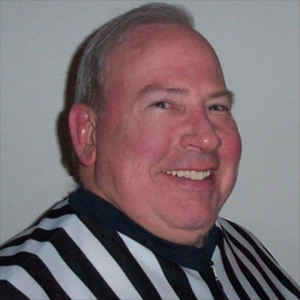
Rndballref
20 Years Experience
Chicago, IL
Male, 60
For twenty years I officiated high school, AAU and park district basketball games, retiring recently. For a few officiating is the focus of their occupation, while for most working as an umpire or basketball referee is an avocation. I started ref'ing to earn beer money during college, but it became a great way to stay connected to the best sports game in the universe. As a spinoff, I wrote a sports-thriller novel loosely based on my referee experiences titled, Advantage Disadvantage
Technically speaking, it is a technical team foul for not coming onto the court in a timely manner after a time out or start of a quarter or overtime. Preventive officiating would dictate giving the team a little leaway to come onto the court, but if a coach refuses then a T should be called.
Sounds like the ref was confused because if the possession team is slow to come on the court it is legitimate to put the ball down on the throw in area and begin a five count. However, when the defense refuses to come out, T is the appropriate penalty, not putting the ball in play without the defense.
ok.
Read my answer to the above question, and add this. If I was observing an official who called a foul on a half court tip a shooting foul, I would do all I could to keep him from working a varsity (also a sophomore) game. I will grant you that a player can go through the habitual shooting motion of a shot anywhere on the court and if fouled it could be a shooting foul, even from the back court (as in the end of the quarter), but a tip from half court is unskilled and undeserving of a shooting foul - I would always call a halfcourt tip foul a common foul.
In the violations section of the rule book regarding free throws, it states that the free throw shooter shall have neither foot beyond the vertical plane of the edge of the free throw line which is further from the basket.
This restriction ends when the ball hits the ring, backboard or until the free throw ends.
So no, a player cannot soar through the air leaping from the semi-circle to dunk a ball - he would have to cross the vertical plane of the free throw line.
Claims Adjuster
Basketball Referee
 Ever get into a physical altercation with a crazed parent?
Ever get into a physical altercation with a crazed parent?
Claims Adjuster
Indirectly referees and the home school have the authority. In NFHS rules there is a function called home management. It is usually the athletic director, or a representative of the AD. The rule book states that in the absence of a designated home management person, the home team head coach will assume that function.
Directly from the rule book: The officials shall penalize unsporting behavior by player, coach, substitute, team attendant or FOLLOWER.
Further the book states: ... the officials may rule fouls on either team if its supporters act in a way to interfere with the proper conduct of the game.
It also cautions the officials to be careful applying penalties so as not to unfairly penalize a team.
When I officiated, I never engaged in an expulsion dialog with a fan. I simply went to home management (the AD) and said something like, "the guy in the third row with the blue shirt has to go. Home management always complied with my request and escorted the unruly fan out (or used an on site police officer to be the escort) and the AD often apologized about a overzealous home team fan.
I don't like the pro game because of how it has evolved, especially in the east. Post a big player on the block, slow the game down to half court, never full court press, winners are too predictable and players turn on/off hustle instead of playing hard the entire game. So I am with you. if I had to pick a player whose game I admire it would Kevin Durant. I despise how Wade, James and Bosh colluded to put their team together, and could have started a league-ruining trend. I like the college D1 game. There are upsets and coaches can piece together unique game plans to try to win. Much less predictibility.
When you catch a ball in the air you are considered to be in the court where you jumped from. So you might think that this play is a violation, but there are two exceptions ... 1) by a defensive player intercepting the ball, and 2) by either team on a throw in.
-OR-
 Login with Facebook
Login with Facebook (max 20 characters - letters, numbers, and underscores only. Note that your username is private, and you have the option to choose an alias when asking questions or hosting a Q&A.)
(A valid e-mail address is required. Your e-mail will not be shared with anyone.)
(min 5 characters)
By checking this box, you acknowledge that you have read and agree to Jobstr.com’s Terms and Privacy Policy.
-OR-
 Register with Facebook
Register with Facebook(Don't worry: you'll be able to choose an alias when asking questions or hosting a Q&A.)